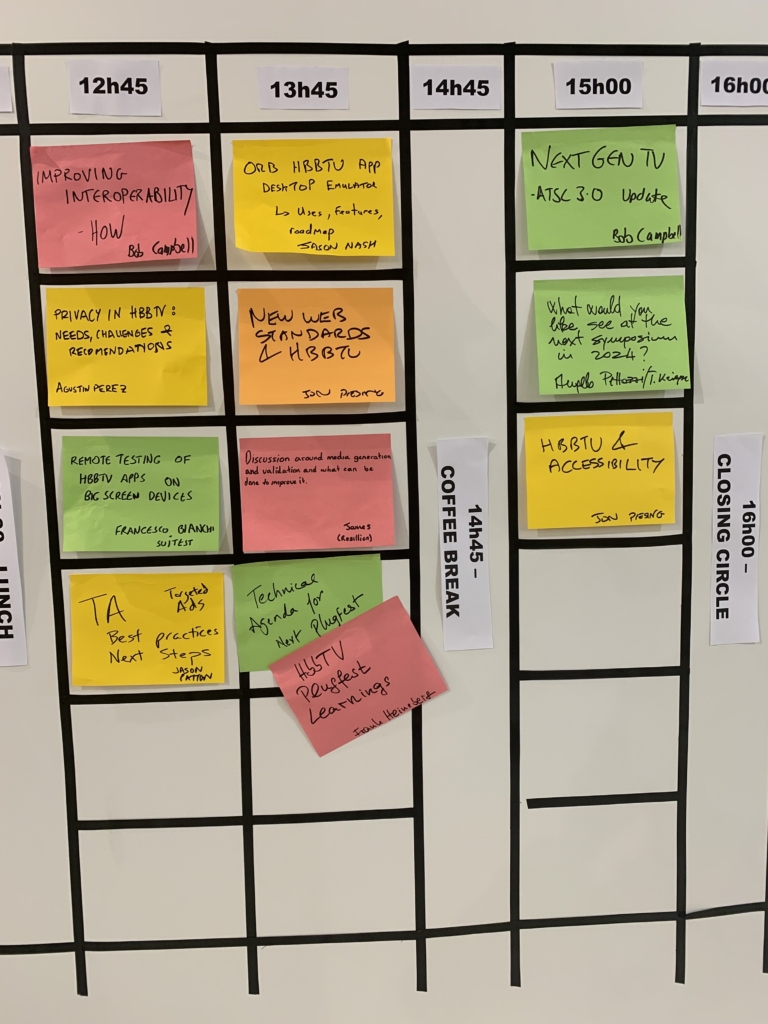11 highlights of the 11th HbbTV Symposium
Discover the evolving world of television technology as we delve into the insights from the 11th HbbTV Symposium in Naples, Italy. From advancements in TV standards to innovations in addressable TV advertising, this post explores how these developments benefit TV viewers, enhancing their content discovery, user experience, and overall engagement. Join us in uncovering the practical advantages that these technological strides bring to the forefront of the television landscape.


1
Broadcasters pushing direct to consumer business models
The 11th HbbTV Symposium unfolded in Naples, Italy. In his opening remarks, Mr. Vincent Grivet set the tone by addressing a crucial industry trend: broadcasters are rapidly adopting both OTT delivery and direct-to-consumer models for big screens. an example of FTA channels new way to reach consumers is Freely’s (https://www.everyonetv.co.uk/news/press-release/new-free-tv-service-via-ip) collaborative approach where they unite forces for a premium content offering.
2
HbbTV Standard Advancements
Moving on to advancements in the HbbTV standard, two new specifications are introduced: 2.0.4 and OppApp. Notably, the latter powers Freely’s success. Additionally, updates on reference applications and the test suite are to be highlighted.
3
TV Sales Steady and Changing Revenue Streams
Paul Gray’s (OMDIA) market review notes positive developments. He emphasizes robust TV sales and CE manufacturers exploring new revenue streams from advertising and subscription services, following the example of Roku and Vizio. However, challenges persist, because up to 70% of SmartTV advertising spending concentrated in the US.
4
Diversifying Recurring Revenues
In the pursuit of diversifying recurring revenues, TV platforms are starting to prioritize them over hardware sales. This involves exploring revenue avenues such as video advertising, revenue sharing with broadcasters/OTT VOD services, audience data, service placements on home screens, and selling custom remote control buttons for OTT providers.
Smart TV advertising has already surpassed TV hardware sales, underscoring the growing importance of recurring revenues over one-time TV device sales.
5
Software’s Rising Importance
A noteworthy shift is observed as consumers increasingly prioritize the quality of TV platforms when purchasing new TVs. This prompts TV manufacturers to adopt a “razor blades or printer cartridge” business models, 75′ TV costs 400€ and recurring revenue possibly up to 100€/year for a single device. Simultaneously, the battle between operating systems, including Android, Tizen, and WebOS, intensifies.
6
Content Discoverability and HbbTV’s Role
From a consumer perspective, this raises the question of content discoverability — how many apps do I need to have installed on my SmartTV to access the content I want: FAST, catch-up, or VOD? In my opinion, HbbTV can address the discoverability of TV services, not by relying on the TV manufacturer, but as an integral part of TV channels. With the rise of OppApp, it can also become an integral part of the TV device itself.
7
DVB-I’s Potential for FAST Channels
DVB-I is making strides with technical trials in Italy, Spain, and Germany, aiming to seamlessly integrate broadcast and broadband channels into one user interface, significantly enhancing content discovery.
However, a crucial question remains regarding the regulation, legislation, and certification regime needed to define roles and responsibilities in its management. The seamless combination of broadcast and broadband services is highly lucrative for content owners, providing cost-effective means for even niche channels to reach larger screens.
Another consideration is how to develop and distribute DVB-I compliant client apps to devices like set-top boxes, streaming sticks, and mobile devices. Nevertheless, progress in technical, business, and legislative realms continues, and we anticipate real production deployments of DVB-I in Europe soon. This addresses the future of TV, where broadcast, OTT, and multicast deliver mainstream content to large audiences, alongside niche thematic and local content in both linear and on-demand offerings.
The challenge lies in defining the regulatory framework for its effective management.
8
Addressable Advertising and DVB-TA Compliant TVs
Addressable advertising is deemed a crucial feature for generating increased revenue from the same ad inventory, emerging as one of the hot topics once again in Naples. While display advertising still has its place, there’s a noticeable shift in focus and high expectations toward dynamic ad substitution. In Italy, Linear Ad replacement has become a daily norm, experiencing a 30% YoY growth with over 100 campaigns in 2023. The most prominent advertiser segments are retail, beverages, and Telco. Two main models have been adopted: replacing the entire ad break with online ads and changing only 1-2 ads within the ad break. Technically, most broadcasters rely on client-side ad replacement and custom pre-buffering of manifests to ensure a seamless transition from broadcast to broadband and back.
What holds great promise is the release of the very first DVB-TA compliant TVs by Samsung, utilized by Mediaset in their dynamic ad substitution business. This development not only makes technical implementation easier but also provides a broader horizontal technology platform for utilization.
9
Promoting HbbTV Engagement for Targeted Advertising
To launch successful targeted advertising in any country, HbbTV should be mandated as the default setting. However, channels must also offer additional beneficial HbbTV services to keep viewers engaged, as seeing only ads may result into reluctance in keeping HbbTV activated on their TVs.
10
Audience Measurement Challenges
A significant focus during the unconference, evident from the substantial audience participation, revolved around audience measurement. Exploring how entities like Barb, GfK, Kantar, and others compare to real-time measurement via HbbTV sparked interesting discussions. Particularly for smaller channels facing zero ratings, HbbTV measurement has proven invaluable. The data from HbbTV audiences clearly demonstrates their presence, even when panel data falls short. However, a challenge persists in persuading advertisers of this reality, given their reliance on official TV ratings. This poses a political question requiring resolution, and it’s crucial to involve both media agencies and official panels—often the gatekeepers between TV and media buyers in many countries. While data collection can be costly, channels must assess whether they can justify the expense with the potential for a larger ad inventory and enhanced visibility into how their programming is consumed.
11
Developer Tools and Industry Support
Concluding on another positive note, Samsung’s release of developer tools for 2024 models is highlighted as a step forward, fostering efforts to enhance UX and cross-platform support within the industry. I hope this paves road for other manufacturers to follow.

HbbTV is a global initiative aimed at harmonizing the delivery of broadcast and broadband services through connected TVs and set-top boxes. It enables broadcasters to deliver interactive content, such as on-demand videos, catch-up TV, and interactive applications, alongside traditional broadcast services.
Read about Icareus’ HbbTV platform: https://icareus.com/products/hbbtv-solutions/
HbbTV symposiums are events where industry professionals, stakeholders, and experts gather to discuss the latest developments, trends, and challenges in the field of hybrid TV. These symposiums often include keynote presentations, panel discussions, technical sessions, and demonstrations of new HbbTV technologies. Participants may include representatives from broadcasting companies, technology providers, regulatory bodies, and other relevant organizations.
More information:
https://www.hbbtv.org/11th-hbbtv-symposium-and-awards-2023/
